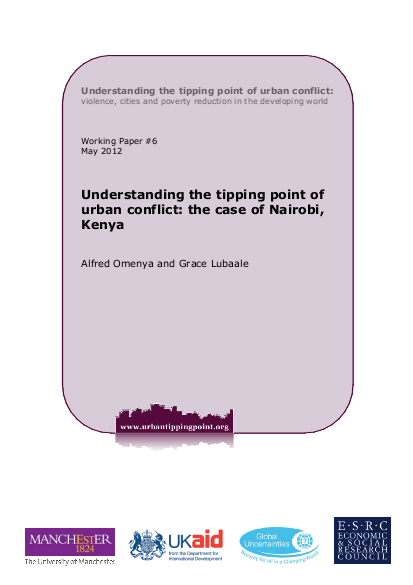Working Paper #6

This research studies the tipping point of urban conflict in Nairobi, Kenya. It employs the concepts of tipping points and violence chains. The research studies various types of conflict and violence at city level through literature and in three of Nairobi’s hotspots: Kawangware, Kibera, and Mukuru settlements, through participatory violence appraisal (PVA). The research shows that the most significant type of violence is political violence. However, cumulatively, other types of violence, namely landlord-tenant, domestic and economic violence, are more significant. Focusing on political violence alone makes other types of violence invisible. The study shows that political violence in Kenya is rooted in colonial times in historical inequity in access to resources, and perpetuated in post-colonial times through the mediation of ethnicity. The study unpacks roles of institutions in tipping conflicts into and out of violence; it shows that an institutional analysis of actors involved in tipping conflict into violence and vice versa is important in preventing violence. It identifies the tipping points at sub-city level and shows the complex ways in which these types of conflict and violence are interlinked through chains. Breaking these violence chains is critical to preventing conflicts tipping into violence. A key way of breaking the chains is improving the overall governance framework. Further the study shows that violence in Nairobi’s sub-city is spatially linked. Thus identification of violence hotspots is critical in dealing with violence; and spatial improvements such as slum upgrading initiatives, taking into consideration hotspots, can go a long way in preventing conflict tipping into violence.
Resource collections
- Topics
- UN Habitat - Urban Response Collection
- Urban Response - Urban Crisis Preparedness and Risk Reduction
- Urban Response Collection - Community Engagement and Social Cohesion
- Urban Response Collection - Economic Recovery
- Urban Response Collection - Environment and Climate Change
- Urban Response Collection - Housing, Land and Property
- Urban Response Collection - Urban Crisis Response, Recovery and Reconstruction
- Urban Response Collection - Urban Resilience
